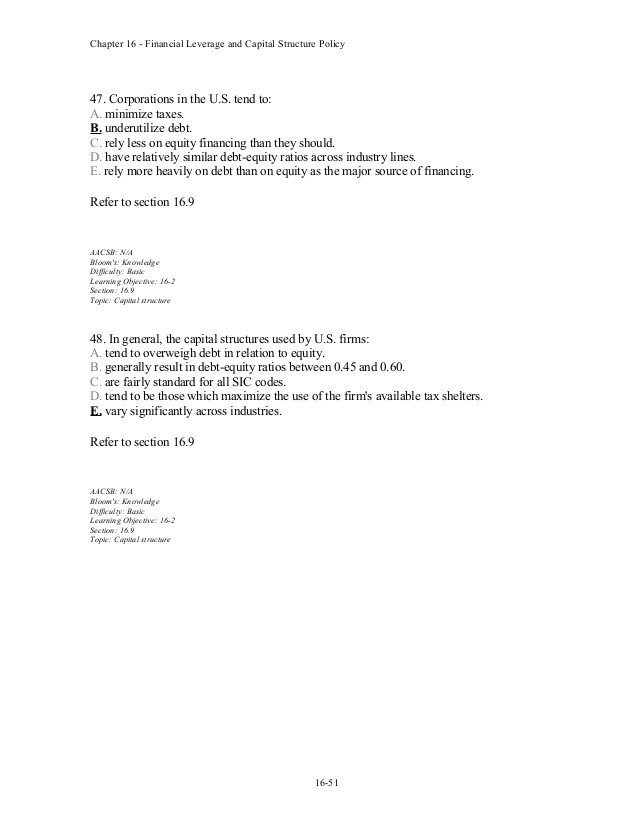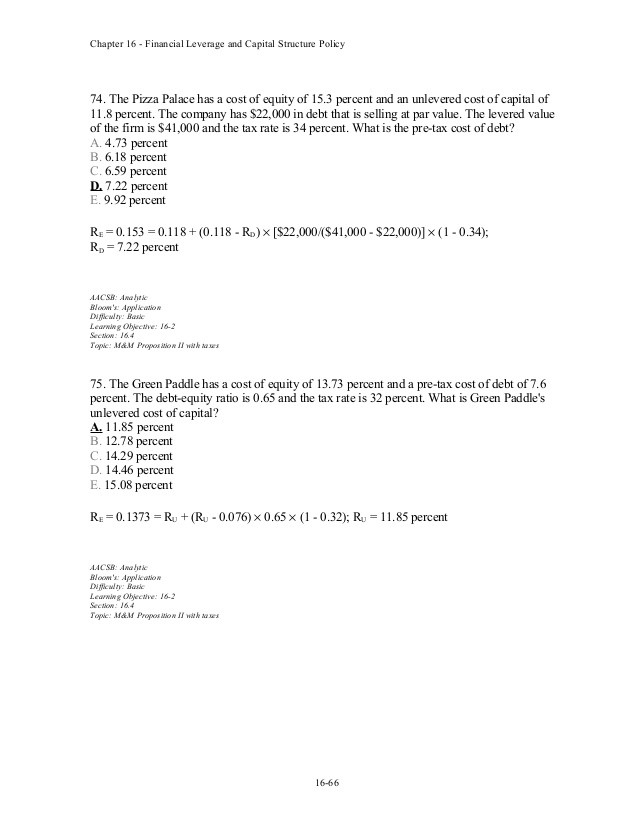The Proposition Of Capital Structure And Corporate Finance Finance Essay
Post on: 25 Сентябрь, 2015 No Comment

Capital structure is, financing portfolio, consisting of the debt and equity because the main funding sources of the corporate are combined by debt and equity. Capital structure theory focus on: If the management authority’s main objective is to make the common shareholders of wealth has reached the maximum, then the capital structure of deciding whether or not to create value for its shareholders?
In other words, through of debt and equity portfolio, management authorities can reduce the corporate capital cost to minimum, and have the maximum share of common stock?
In theory, make it easy to find an optimal capital structure, but in practice is that, the corporate there is a perfect match of capital structure is extremely difficult to be proved.
In fact, under what conditions should select liabilities, rights, interests, or hybrid securities, the decision-making application was subjective of the corporate and investors because these factors influence the capital structure of not clearly to decide just like a mystery (Myers 1984).
Capital structure theory has its roots in 1958 Modigliani & Miller “The Cost of Capital, Corporation Finance and the Theory of Investment”, also called as MM’s theory, and then this article lays the capital structure theory basis and began. In this article, the assumptions are not realistic, so that there are many scholars put forward some explanations and statements. At the same time, the scholars try to solve the theory by the different factors for example: the taxes, bankruptcy costs, and asymmetric information…etc. The different factors have given notice of the capital structure of a reasonable explanation because MM’s theory showed that the financing decision doesn’t matter in perfect capital markets but in practice, capital structure does matter.
The MM’s theory can help us to understand those conditions, why a particular capital structure is better than another. In addition, the theory tells us what kinds of market imperfection we need to look for and pay attention to.
The Proposition of Modigliani & Miller Theory
The idea of the Modigliani & Miller Theory (1958) is the corporate investment and financing are separated and independent so the corporate market value is not related to the contents of the financing. Therefore, the most appropriate capital structure does not exist.
Base on the Modigliani & Miller Theory (1958), the restrictive assumptions are shown as follows:
the capital market is perfect and there are no corporate income tax, personal income tax, bankruptcy cost, transaction cost, flotation cost, agency cost…etc
All the securities can be infinity
All the investor are clearly understand and sensible their investment decision, that means they have the same expectation including the future EBIT(earning before interest and tax). net profit and the risk of the business
Investors can enjoy the corporate default risk-free interest rate for financing
The corporate published or build bonds, will not change the level of operational risk
The operation risk can be measured by the standard deviation of EDIT, if the corporate operational risk is the same; they are a member of the same risk rank.
The corporate funding sources only no risk liabilities and shareholders ‘ rights
Dividend policy would not be considered
Investors and corporate management on the corporate future prospects, and is expected to be the same, that means no Asymmetric Information.
According to the above assumption of MM’s theory, when the corporate and personal income tax is not existed, the corporate value and capital cost is not affected by the impact of capital structure, this conclusion is known as the capital structure irrelevance theory.
After the capital structure irrelevance theory (1958) publication, there are many criticisms by many scholars, so Modigliani & Miller (1963), amendment, is appeared. In this article, all assumptions are same as Modigliani & Miller Theory (1958) unless the corporate income tax was relaxed. The corporate income tax raising loan interest payments resulting from the cost of processing can be used as. Therefore, it is possible to reduce the corporate cash outflow that mean the corporate income tax can be eliminated by the loan interest.
Considering to relax the corporate income tax, the corporate value would be affected by the debt ratio when the debt ratio grow then the value of the corporate also grow. On the other side, the weighted average cost of capital with the improvement of the debt ratio falls.
Thus, considering relaxing the corporate income tax, the corporate value and capital cost is affected by the impact of capital structure, this conclusion is known as the capital structure relevance theory.
Base on the Modigliani & Miller Theory (1963) of the opinion that the borrowing of 100% will enable maximised enterprises’ value.
The Modification of Modigliani & Miller Theory
Differential Personal Income Taxes
In Miller (1977), the personal income tax is included in the consideration of capital structure. In this article, all assumptions are same as Modigliani & Miller Theory (1963) except the personal income tax. Miller (1977) discussed the corporate income tax and personal income taxes were exist at the same time, the effect of enterprises’ value.
Miller (1977) pointed out the following information, there are no such as Modigliani & Miller (1963), who can take advantage of 100% means that the borrowing of financing:
The values are equal between Liability Corporate and Non-liability Corporate,

The liability could be brought by the tax saving benefits.
The interests and tax-efficient depends on corporate income tax rates, personal dividend income tax rates, and personal interest income tax rate to be determined.
While a corporate use of financial leverage into, will be contributing to the rapid rise in the cost of capital.
In addition to the Modigliani & Miller (1963) as proposed by the liabilities of the tax shield can increase the value of the corporate, DeAnglelo & Masulis (1980) also raised in a non-tax liabilities, the shield that enhance the value of the corporate can enjoy the benefits of the tax shield, such as asset depreciation expense, research and development, investment concessions and advertising expenditure…etc. Then, in the static case, non-tax liabilities included in the shield decision taking into account the capital structure, the corporate also have an optimal capital structure optimal.
Trade-off Theory
In MM’s theory (1963), the tax shield debt interest can increase the value of the corporate. However, many scholars found that when the increase in financial leverage, the Leverage Related Cost has been carried, and then, these costs will be offset by the benefits interest of liabilities. After weighing the variety of benefits and costs of borrowing, the corporate will be able to achieve a balanced capital structure. This is known as Trade-off Theory which proposes the corporate have an optimal capital structure.
Under Trade off Theory, every corporate in the marginal cost of debt is equal to the marginal benefits, set the target of the corporate capital structure — this is the optimal capital structure. When the actual capital structure departure from the capital structure of optimal level, the corporate will adjust its capital structure (that is, the debt ratio) to maintain the best level.
Pecking Order Theory
In Myers (1984), taking advantage of Pecking Order Theory to document, in the process of financing for corporate, there is asymmetric information between management authorities and foreign investor. For this reason, when make the financing decisions to raise fund, the corporate preferences to use the lowest transaction costs, own funds, at first, borrowing at second and the issue of new shares at last.
The emergence of the above situation is because the information asymmetry arising from messages cost, such as the issue of new share’s transaction cost, which is much more important than the Trade-off Theory of the Leverage Related Cost. In order to reduce the information asymmetry arising of the information costs, and other financing costs, the corporate will choose the cheapest sources of funds. Therefore, the corporate might use the internal funds rather than the funding from external sources .While using the external fund unavoidable, the corporate will base on the cost low and high to consider using the “liabilities” or “common stock” to raise funds. Base on this rule, the optimal capital structure is not the main concern when the management authorities plan the financing decision, the most important is how to avoid the conflict as much as possible and the cheapest financing tools. So that, under Pecking Order Theory, the capital structure of the corporate is not clear and the debt ratio just is the investment decision, dividend policy and external and internal financing decision interacting results.
Conclusion
In Modigliani & Miller Theory, the corporate capital structure is irrelevant to corporate finance. According to the above discussion, the restrictive assumption is unrealistic; the theory can match in a perfect market only. In practice, there are many factors should be considered, such as, the taxes, bankruptcy costs, and asymmetric information…etc.
The corporate financing decision will be affected by different factors, so that many scholars conclude these factors to explain the capital structure in practice.
Conclusively, the statement of “proposition that a firm’s capital structure is irrelevant for a study of corporate finance” is invalid.














